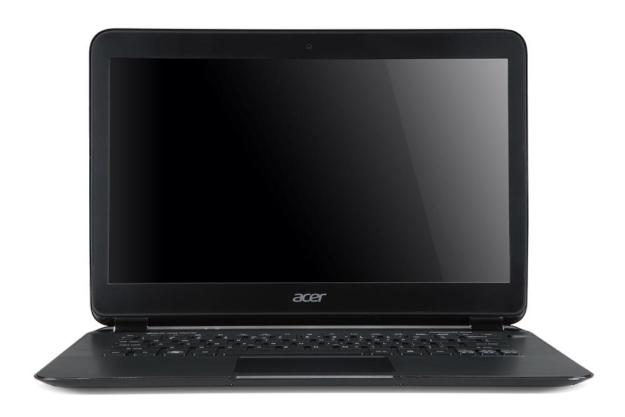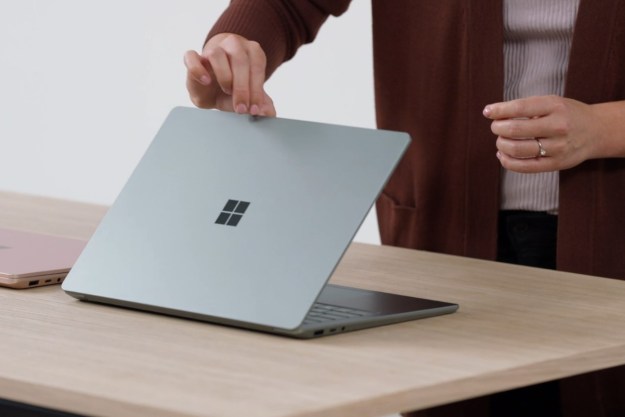
“Nothing about the S5 justifies the price disparity between it and the Aspire M5, and nothing makes it competitive with other expensive Ultrabooks.”
- Fast processor
- Absurdly quick solid-state drives
- Among the thinnest, lightest laptops available
- Bland design
- Annoying connectivity
- Average display
- Small battery
- Massively overpriced
Acer was one of the first companies to jump into the pool of Ultrabooks. The Acer Aspire S3, which we reviewed last year, was a competent first entry. Battery life could have been better and performance was only so-so, but the laptop was otherwise competent.
Ultrabooks have marched on since then and now are updated with the latest third-generation Intel Core processors. Acer has launched several new Ultrabooks with this updated hardware. One is the S5, a laptop Acer started to show off early this year but only now has put into production.
At first glance, the S5 seems unremarkable. Our review unit arrived with a Core i7-3517U low-voltage processor, 4GB of RAM and Intel HD 4000 integrated graphics. The display panel is 1366 x 768, which is as common as one could possibly imagine.
The Acer S5 has some oddities, however. The laptop has not one but two solid state drives – a pair of 128GB drives linked via RAID0. The S5 also maintains an extremely thin .59-inch-thick frame by hiding its connectivity in a drop-down panel on the back of the laptop. The panel opens or closes with the press of a button beside the keyboard.
Such changes could have a big impact on the S5’s performance and usability, but this is also a 13.3-inch Ultrabook, and as such it needs to live up to certain standards. Does the S5 fix the S3’s short battery life, for example? Let’s find out.
Video review
Design
Acer is not known for striking designs. The Acer Aspire S5 is an example of the company’s least inspired efforts. This is a laptop. It has keys. It has a display. It has a touchpad. Oh, and it’s thin. The end.
The S5’s design looks more like a production prototype than a retail product. The basics are similar to the Acer Aspire S3 – the edges of the laptop curve rather than point, the rear of the chassis (just under the display) has a small lip of material and the lid itself is plain, flat metal. But the silver finish of the S3 looked more, well, finished; the black S5 just looks drab.

Although panel gaps are tight, the chassis suffers from minor flex issues. This is all too common among Ultrabooks and never is acceptable.
As mentioned, the S5 hides its connectivity in a panel that drops from the bottom rear of the laptop with the press of the button. This panel hides two USB 3.0 ports, a Thunderbolt port and HDMI. A headphone jack is located on the right side of the laptop near the rear of the chassis.
The drop-down panel opens and closes with an annoying mechanical whirr that sounds like the motor in a cheap remote-control toy. We can’t help but wonder if Acer could have found a more elegant solution.
User interface
The S5’s keyboard reflects the laptop’s design: basic and lacking outstanding traits. It’s a good keyboard, however, which instantly makes it better than those found on some competitors. Some key travel and individual keys are well separated from those around them. Our only major complaint is the layout. Some keys are much smaller than they need to be, such as the arrow keys and the backspace key.

Backlighting is not an option on this laptop. That’s disappointing because most competitors offer a backlit keyboard; it’s usually standard equipment. Its absence is notable in light of this Acer’s high price tag.
What about the touchpad? As with the rest of the laptop – well, it’s a touchpad. Touch it, and the cursor moves. The touchpad is neither large nor small. It’s neither touchy nor unresponsive. Multi-touch gestures work as you’d expect for a Windows 7 laptop, which is to say they do work, but they aren’t smooth.
Display and audio quality
High-end Ultrabooks are raising the bar on what consumers can expect from laptop displays. The Envy line has its Radiance display, and Asusnow offers a 1080p-IPS option on its Zenbook Prime. Among this competition, the Acer Aspire S5’s glossy 1366 x 768 display is at an obvious disadvantage right out of the gate.
We found no improvement when examining test images. Black levels are average, and gradient banding performance, while reasonably smooth, shows some noticeable bands across the entire test image. Viewing angles are typical of a laptop panel, and images lack uniformity as a result.
We’d be wrong to say that the S5’s display is worse than average, but it’s not better than average. Buyers are going to expect more from a laptop with a MSRP well above $1,000.
Sound quality is a high point. Ultrabooks struggle in this area, but the S5 surprised us with decent sound reproduction in all situations. Maximum volume is acceptable; some bass reproduction is available and results in no distortion.
Cooling
The retractable connectivity panel mentioned earlier in this review isn’t just for plugging in peripherals. It is also an important part of the cooling system. When the S5 is running warm, the system automatically opens the rear panel to provide additional cooling.
It’s an odd feature, but it works. During benchmarks, we noted that most of the laptop’s keyboard remained under 90 F. The laptop’s fan is also quieter and less annoying than those found in some competitors.
This is a thin laptop, however, and sustained loads can take their toll. During our PCMark 7 benchmark, we noted temperatures along the bottom-rear of the laptop eventually reached 109 F. That’s too high for comfortable lap use.
Portability
One problem with thin design is the lack of battery space. Acer’s Aspire S5 does nothing to solve this problem. It ships with a three-cell battery that has an exceptionally low-rated capacity of 2,310mAh. This is just slightly larger than the capacity of the average smartphone battery.
Poor battery life is the predictable result. The S5 ran for just one hour and 33 minutes in the Battery Eater load test. Using the light-load Battery Eater Reader’s Test extended life to five hours and 40 minutes, which is adequate but well short of the best battery life in this category.

At least the S5 is easy to pack. Its weight of 2.6 pounds and thickness of .59 inches makes the Acer Aspire S5 one of the thinnest and lightest
Software
Acer packs a fair number of shortcuts onto S5’s desktop, including Acer Games, AcerCloud, eBay andNetflix shortcuts and more. Seeing so many icons on the desktop when you first boot is distracting, but many of them are bookmarks rather than shortcuts to program, and everything stays out of the user’s way unless you click on an icon.
The one exception is McAfee Internet Security. As usual, it frequently prompts the user for various actions and generally makes itself a pain in the butt. That’s not unique to the S5, however. McAfee is on many company’s computers and is equally annoying on all of them.
Performance
One look at the spec sheet is all you need to determine that the S5 is meant to be a performance Ultrabook. The Core i7-3517U dual-core, which has a base clock of 1.9GHz and a maximum Turbo Boost clock of 3GHz, is Intel’s quickest low-voltage processor. This is backed up by two solid-state drives in RAID0.
In our processor benchmarks, the 3517U posted great scores for a low-voltage part. In SiSoft Sandra it reached a combined score of 40.65 GOPS, and 7-Zip returned a combined score of 8,302 MIPS. These scores are higher than any other low-voltage processor we’ve tested by a significant margin and about 15 percent lower than the scores of the Lenovo ThinkPad X230, a laptop with a standard-voltage, third-generation Core i5.
In PCMark 7, the Acer Aspire S5 achieved a score of 6,436. That’s significantly better than the Alienware M17x, which scored 4,594. Storage scores are the reason for the result. Transfer speed benchmarks showed the S5 posting average transfer rates of about 850MBps, which is just obscene.
The S5’s 3D performance, on the other hand, is poor. 3DMark 06 reached a score of 5,603 while 3DMark 11 returned a score of 637. Both of these are on par with other Ultrabooks and represent the ability to play many 3D games at low resolution. Some modern titles will give you trouble, however, unless you turn off most detail options.
Conclusion
The Acer Aspire S5 is an odd duck. It is extremely thin and provides excellent performance in some areas. We’re unaware of another Ultrabook that can match the Acer Aspire S5’s hard-drive performance, and most Ultrabooks also will be dusted by its Core i7-3517U processor.
But then we look at the price. Whoa, $1,399 is a lot of dough – and the S5’s design comes nowhere close to supporting it. Similarly priced competitors such as the 13.3-inch MacBook Air, HP Envy 14 Spectre and ASUS Zenbook are in another league. Even Acer’s less expensive Aspire M5 is a better computer.
Matters are made worse by the S5’s lackluster battery life and absolutely average display. A 1366 x 768 panel of middling quality has no business in a laptop this expensive. That fault alone is enough to dismiss the S5 from any recommendation.
Nothing about the S5 justifies the price disparity between it and the Aspire M5, and nothing makes it competitive with other expensive Ultrabooks. Look elsewhere if you have money burning a hole in your pocket.
Highs
- Fast processor
- Absurdly quick solid-state drives
- Among the thinnest, lightest laptops available
Lows
- Bland design
- Annoying connectivity
- Average display
- Small battery
- Massively overpriced
Editors' Recommendations
- 9 best 2-in-1 laptops in 2024: tested and reviewed
- This Acer OLED laptop (almost) beats the MacBook Air 15 — and it’s cheaper
- The new Asus Zenbook S 13 is like a MacBook, only better
- CES 2023: Acer’s new Swift Go has a 1440p webcam — take that, MacBook Air!
- CES 2023: Acer’s redesigned Predator Helios 18 looks like a winner


